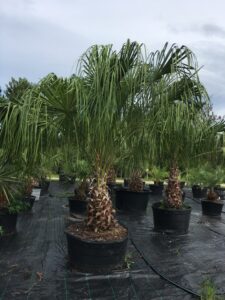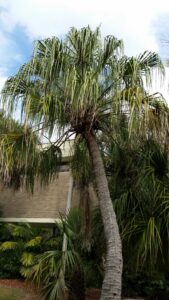Ribbon Palm / Weeping Cabbage Palm
( Livistonia decipiens )
Ribbon Palm / Weeping Cabbage Palm Origins:
– Livistonia decipiens is native to the Eastern coastal portion of Australia, they can be found growing in low lying areas along forest edges and swamps and makes an excellent ornamental palm specimen for the North Florida / Jacksonville / St. Augustine area commercial and residential landscapes.
– Ribbon Palm / Weeping Cabbage Palms highly ornamental foliage has a dramatically weeping habit, and makes this a decorative addition to the landscape.
Ribbon Palm / Weeping Cabbage Palm Preferred Exposure:
– Full sun is preferable in the North Florida landscape but Ribbon Palm / Weeping Cabbage Palm will also tolerate a partial shade and partial sun location without difficulty.
Ribbon Palm / Weeping Cabbage Palm Fronds | Trunk:
– Foliage of the Ribbon Palm / Weeping Cabbage Palm will remain evergreen in the North Florida landscapes and is cold hardy with no damage down to 20 degrees F.
– The leaves of the Ribbon Palm / Weeping Cabbage Palm have a fan shape that is split into thin strap like portions that hang down like ribbons giving the palm both its common name and it’s “waterfall effect” on its foliage.
– Palms are single trunk specimens and trunks may reach 10 inches in
diameter.
Ribbon Palm / Weeping Cabbage Palm Soil  Preference / Salt tolerance:
Preference / Salt tolerance:
– Ribbon Palm / Weeping Cabbage Palm planted in the North Florida |
Jacksonville | St. Augustine landscape will tolerate virtually any soil components.
– Salt tolerance is moderately high and Ribbon Palm / Weeping Cabbage Palm may be planted on coastal properties.
Ribbon Palm / Weeping Cabbage Palm Size Variance:
– Although Ribbon Palm / Weeping Cabbage Palm are only a moderately fast grower they can reach sizes of 30-50 feet H | and spreading 10-15 feet in width.
Ribbon Palm / Weeping Cabbage Palm Growth Habit:
– Livistonia decipiens has a tight full crown that forms a rounded
shape on its tall somewhat slender trunks. Similar in appearance to the Florida Native Sable Palm / Cabbage Palm but with much more decorative foliage.
Ribbon Palm / Weeping Cabbage Palm Growth Rate:
– Moderate growth rate.
Ribbon Palm / Weeping Cabbage Palm Bloom:
– Huge 4-9 ft long bloom clusters of yellow flowers followed by yellow fruits that ripen to a dark purple black.
Ribbon Palm / Weeping Cabbage Palm Water Requirements:
-Ribbon palms will benefit from supplemental irrigation in the landscape and can be planted into areas that are well draining or lowlands with more wet soils during the rain season.
Best Uses For Ribbon Palm / Weeping Cabbage Palm in the North Florida |Jacksonville | St. Augustine landscape:
– Ribbon Palm / Weeping Cabbage Palm is an excellent choice for a landscape statement for smaller frontage more modern yards and gardens or commercial buildings, plant in groups of three for added curb appeal in larger garden settings.
Care of Ribbon Palm / Weeping Cabbage Palm / Jelly Palm:
– Ribbon Palm / Weeping Cabbage Palm will need good water during the establishment period and will benefit from supplemental irrigation once planted in the ground from the S & J Nursery container.
– Prune out older browned out fronds as needed to help keep the palm looking its best.
– Fertilize 1-3 times each year depending on desired growth rate and landscape setting conditions.
MINIMUM PALM FERTILIZER REGIMEN – what you should be doing to keep your palm
healthy
– Fertilize each spring with a specially blended fertilizer for Palms, follow
manufacturers directions and apply 1/2 lb o 1lb of fertilizer per inch of diameter of trunk on your palm, measured from a hands width above the ground level. That means for a 12 inch wide trunk from left to right you
would need 6-12 lbs of fertilizer for just that one palm!
– Fertilize every fall with magnesium sulfate ( Epsom Salt) to keep your palm green and healthy through the winter months!
MAXIMUM PALM FERTILIZER REGIMEN – what you can do to get your palm up and growing Fast!
– Fertilize every three months with your choice of Palm fertilizer and
Magnesium Sulfate. Water 3-4 times per week and make sure to water thoroughly after each fertilizer application.
– Wait till fronds have turned completely brown before removing from the palm as the palm will take back in the nutrients from those older leaves ad use it when forming new ones.
*CAUTION – DO NOT FERTILIZE NEWLY PLANTED
/ TRANSPLANTED
FIELD GROWN PALM TREES WITH PALM
FOOD!
Note : When planting smaller palms being grown in a container, this rule does not apply, rather, use half the recommended application rate for your trunks diameter, as container grown palm roots have not been damaged or cut during planting but are still only a portion as large as they would be if the palm had been growing in the ground and excess fertilizer on a confined root system is still not preferable for maximum health.
Palm fertilizers are water soluble and will burn the new roots your palm tree is trying to put out as it establishes itself into the landscape. It is best to use only poly coated plant food that is heat release like Osmocote general purpose fertilizer or non burning Milorganite in the first year in the landscapes, and then the following year, start your palm food regimen that will provide all of the minor nutrients that your palms will need to keep them healthy and problem free in Florida’s soils.


